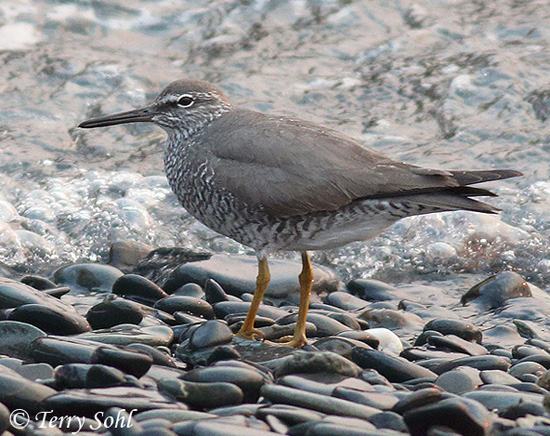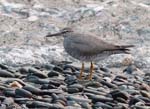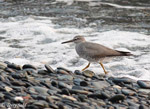| Length: 11 inches | Wingspan: 26 inches | Seasonality: Non-resident in South Dakota |
| ID Keys: Slate gray overall, lighter below, black and white stripe in front of eye, heavy barring on breeding birds | ||
 The
Wandering Tattler is named for it's loud "tattling" call given when a bird
is disturbed and takes flight. It takes the title of "Wandering"
Tattler due to the wide geographic range on which they can be found. They
are only found in Alaska and northwestern Canada during the summer breeding
season, but wintering birds can be found on rocky coastlines of much of
western North America, with some moving as far south as the western coast of
South America.
The
Wandering Tattler is named for it's loud "tattling" call given when a bird
is disturbed and takes flight. It takes the title of "Wandering"
Tattler due to the wide geographic range on which they can be found. They
are only found in Alaska and northwestern Canada during the summer breeding
season, but wintering birds can be found on rocky coastlines of much of
western North America, with some moving as far south as the western coast of
South America.
Habitat: Found near rocky mountain streams during the summer breeding season. In migration and in winter, found on rocky coastlines, including man-made rocky structures such as breakwaters and piers.
Diet: Feeds on insects, mollusks, crustaceans, marine worms, and other small invertebrates. Insects make up much of the diet during the breeding season.
Behavior: Forages by quickly walking along rocks, stopping to pick up food items when they are spotted.
Nesting: The nest of a Wandering tattler is a depression on the ground, sometimes lined with grasses, leaves, and twigs, or sometimes unlined. The female usually lays 4 eggs, and both parents help to incubate them. When the eggs hatch, the young leave the nest almost immediately and start searching for their own food. Both parents tend to and protect the young for the first couple of weeks, but typically only one parents remains after that.
Song: Flight call of a Wandering Tattler is a clear piping trill. The flight song given on breeding grounds is a whistling deedle-deedle-deedle-deeee.
Migration: Migratory. Breeding birds in North America are found in Alaska and in northwestern Canada. Wintering birds can be found along the coast of from southwestern Canada, all the way down to the northwestern coast of South America.
Interactive eBird map: Click here to access an interactive eBird map of Wandering Tattler sightings
Similar Species: Most likely to be confused with the Willet, particularly in non-breeding plumage, when barring on the underparts isn't present.
Conservation Status: Populations are generally stable, and they are found over a relatively wide geographic area. The IUCN lists the Wandering Tattler as a species of "Least Concern".
Further Information: 1) Cornell's All About Birds - Wandering Tattler
2) BirdWeb.org - Wandering Tattler
3) Audubon - Wandering Tattler
Photo Information: Photo taken on May 20th, 2014 near Homer, Alaska - Terry Sohl
| Click below for a higher-resolution map |
 |
| South Dakota Status: Non-resident in South Dakota |
Additional Wandering Tattler Photos
Click for a higher-resolution version of these photos


